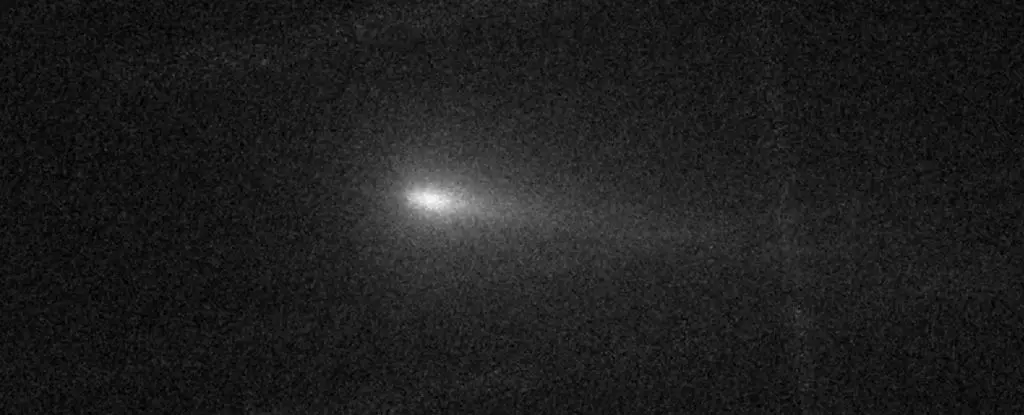The cosmos is a theater of mesmerizing phenomena, and comets, in particular, have captivated humanity’s imagination for centuries. One such celestial object, Comet C/2024 S1, captured attention recently due to predictions that it would be bright enough to see with the naked eye during Halloween. However, this comet is now in the throes of disintegration, raising fascinating questions about the life cycle of such bodies and their impact on our understanding of the solar system.
Discovered on September 27, C/2024 S1 is a Kreutz sungrazer comet, known for its perilous trajectory that brings it perilously close to the Sun—approximately 1.2 million kilometers away—on October 28, 2024. A comet’s approach to the Sun is often marked by a captivating display of brightness as it sheds ice and gas, forming a glowing tail. Unfortunately, this comet seems to be in the process of disintegration before it reaches its closest approach. Images captured throughout October depict the comet brightening initially, followed by a subsequent dimming, indicating a possible fragmentation of its nucleus.
Astronomical observations have shown flares of brightness associated with outbursts, a phenomenon that typically reflects a rapid release of gas and dust. While outbursts can occur due to a variety of disturbances related to a comet’s makeup—ice sublimating and causing pressure inside—the recent observations suggest more severe underlying instability. The resultant fragmentation of the comet’s nucleus has left behind only a faint trace of its former self, raising concerns among astronomers about whether it would fulfill its anticipated visual splendor.
Understanding why C/2024 S1 is breaking apart involves delving deep into the science of comets. Composed mainly of ice, dust, and other volatile compounds, these celestial objects reside in the frigid outer regions of the solar system. As they approach the Sun, they begin to undergo intense heating, causing the volatile materials to change states—sublimating from solid to gas. This process often results in a dramatic increase in pressure within the comet, which can create stresses leading to fragmentation.
The phenomenon of fragmentation remains enigmatic. Although it is clear that the increased rotational forces can divide the nucleus into smaller pieces, astronomers do not fully understand why some comets disintegrate while others endure. C/2019 Y4 serves as a recent case study; it shattered into numerous fragments in 2020, providing unprecedented insights into how such ephemeral celestial bodies can behave under solar forces.
The anticipation surrounding C/2024 S1 had been significant, with expectations that it would appear more brilliant than Venus or even be visible in daylight. Disappointment now looms as it seems likely that the comet will not fulfill these high expectations due to ongoing disintegration. Yet, this predicament is not uncommon among comets that follow similar trajectories. The Kreutz family of comets, of which C/2024 S1 is a member, has historical ties to the Great Comet of 1106 CE, which fragmented and resulted in its descendants, further complicating the history of these celestial bodies.
In light of its potential instability, the current visibility forecasts suggest that northern observers might only glimpse a faint scattering of debris should the nucleus completely disintegrate. However, excitement lingers; fragments of the original nucleus may still be propelled along the comet’s journey, creating a possibly spectacular tail that could continue to be visible even if its head vanishes from sight.
As we observe the disintegration of C/2024 S1, it serves as a reminder of the volatile nature of celestial bodies and the unpredictability of astronomical phenomena. Astrophotographers and amateur astronomers are still eager to spot C/2024 S1, particularly in the Southern Hemisphere where visibility remains promising. Post-perihelion observations could yield interesting results—if any part of the nucleus survives, we might witness a long, curly tail gracing the night sky, devoid of the bright head we had hoped for.
Despite the letdown of seeing the comet potentially fade into obscurity, one thing is for certain: the universe continually educates us. With patience and observation, we shall learn about the life cycles of comets and the forces that govern their existence. So, while C/2024 S1 may not fulfill its initial promise, its disintegration underscores the wonder and mystery inherent in our universe, encouraging both professional astronomers and enthusiasts to remain vigilant in their pursuit of knowledge. Happy stargazing!

Leave a Reply